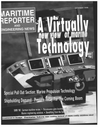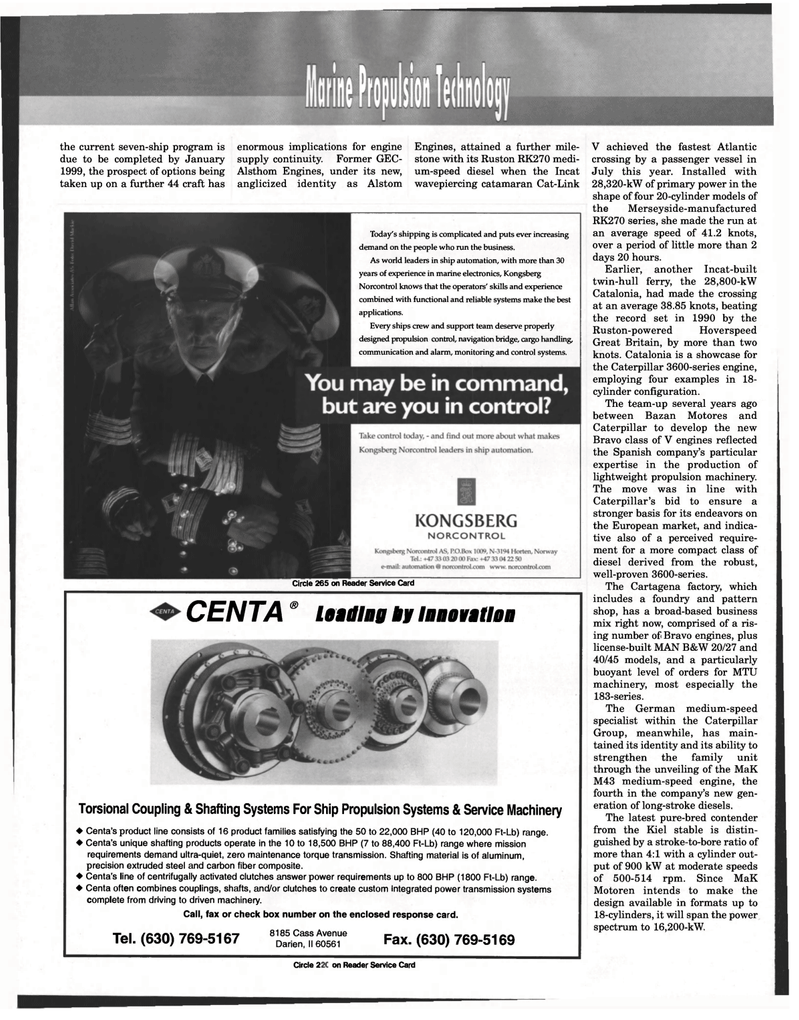
Page 56: of Maritime Reporter Magazine (September 1998)
Read this page in Pdf, Flash or Html5 edition of September 1998 Maritime Reporter Magazine
the current seven-ship program is due to be completed by January 1999, the prospect of options being taken up on a further 44 craft has enormous implications for engine supply continuity. Former GEC-
Alsthom Engines, under its new, anglicized identity as Alstom
Engines, attained a further mile- stone with its Ruston RK270 medi- um-speed diesel when the Incat wavepiercing catamaran Cat-Link
V achieved the fastest Atlantic crossing by a passenger vessel in
July this year. Installed with 28,320-kW of primary power in the shape of four 20-cylinder models of the Merseyside-manufactured
RK270 series, she made the run at an average speed of 41.2 knots, over a period of little more than 2 days 20 hours.
Earlier, another Incat-built twin-hull ferry, the 28,800-kW
Catalonia, had made the crossing at an average 38.85 knots, beating the record set in 1990 by the
Ruston-powered Hoverspeed
Great Britain, by more than two knots. Catalonia is a showcase for the Caterpillar 3600-series engine, employing four examples in 18- cylinder configuration.
The team-up several years ago between Bazan Motores and
Caterpillar to develop the new
Bravo class of V engines reflected the Spanish company's particular expertise in the production of lightweight propulsion machinery.
The move was in line with
Caterpillar's bid to ensure a stronger basis for its endeavors on the European market, and indica- tive also of a perceived require- ment for a more compact class of diesel derived from the robust, well-proven 3600-series.
The Cartagena factory, which includes a foundry and pattern shop, has a broad-based business mix right now, comprised of a ris- ing number of Bravo engines, plus license-built MAN B&W 20/27 and 40/45 models, and a particularly buoyant level of orders for MTU machinery, most especially the 183-series.
The German medium-speed specialist within the Caterpillar
Group, meanwhile, has main- tained its identity and its ability to strengthen the family unit through the unveiling of the MaK
M43 medium-speed engine, the fourth in the company's new gen- eration of long-stroke diesels.
The latest pure-bred contender from the Kiel stable is distin- guished by a stroke-to-bore ratio of more than 4:1 with a cylinder out- put of 900 kW at moderate speeds of 500-514 rpm. Since MaK
Motoren intends to make the design available in formats up to 18-cylinders, it will span the power spectrum to 16,200-kW.
Today's shipping is complicated and puts ever increasing demand on the people who run the business.
As world leaders in ship automation, with more than 30 years of experience in marine electronics, Kongsberg
Norcontrol knows that the operators' skills and experience combined with functional and reliable systems make the best applications.
Every ships crew and support team deserve properly designed propulsion control, navigation bridge, cargo handling, communication and alarm, monitoring and control systems.
Circle 265 on Reader Service Card
CENT A leading by Innovation
Torsional Coupling & Shafting Systems For Ship Propulsion Systems & Service Machinery • Centa's product line consists of 16 product families satisfying the 50 to 22,000 BHP (40 to 120,000 Ft-Lb) range. • Centa's unique shafting products operate in the 10 to 18,500 BHP (7 to 88,400 Ft-Lb) range where mission requirements demand ultra-quiet, zero maintenance torque transmission. Shafting material is of aluminum, precision extruded steel and carbon fiber composite. • Centa's line of centrifugally activated clutches answer power requirements up to 800 BHP (1800 Ft-Lb) range. • Centa often combines couplings, shafts, and/or clutches to create custom integrated power transmission systems complete from driving to driven machinery.
Call, fax or check box number on the enclosed response card.
Tel. (630) 769-5167 8185 Cass Avenue Darien, II 60561 Fax. (630) 769-5169
Circle 211 on Reader Service Card

 55
55

 57
57
